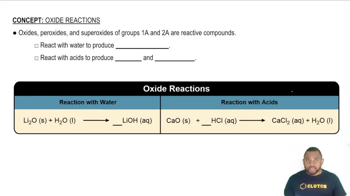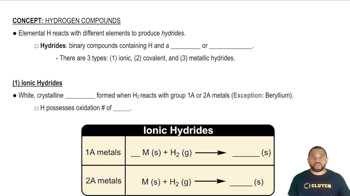Here are the essential concepts you must grasp in order to answer the question correctly.
Acidic Oxides
Acidic oxides are oxides that react with water to form acids or with bases to form salts. They are typically formed by nonmetals or metalloids and exhibit covalent bonding characteristics. Understanding the nature of acidic oxides helps in predicting the behavior of the corresponding hydrides, as these oxides often indicate the element's tendency to form covalent compounds.
Recommended video:
Ionic vs. Covalent Hydrides
Hydrides can be classified as ionic or covalent based on the type of bonding present. Ionic hydrides are formed between metals and hydrogen, characterized by the transfer of electrons, while covalent hydrides involve the sharing of electrons between nonmetals and hydrogen. The nature of the hydride formed is influenced by the element's electronegativity and its bonding characteristics, which are often indicated by the type of oxide it forms.
Recommended video:
Electronegativity and Bonding
Electronegativity is a measure of an atom's ability to attract and hold onto electrons. Elements with high electronegativity tend to form covalent bonds, while those with lower electronegativity are more likely to form ionic bonds. In the context of the question, an element that forms an acidic oxide typically has high electronegativity, suggesting that it is more likely to form a covalent hydride rather than an ionic one.
Recommended video:
 Verified step by step guidance
Verified step by step guidance

